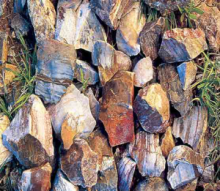Article
Also known as chert, flint is an exceptionally hard sedimentary rock that is therefore especially desirable when making stone tools that need to have and keep edges. Flint is found most often in masses of nodules that, when fractured, break into sharp-edged pieces. For at least two million years, humans have used a chipping method known as flint knapping to shape flint rock into spear points, arrowheads, blades, and other sharp tools.
Depending on soil composition, chert can occur in a wide range of colors. The term flint is generally used to indicate the darker varieties of chert. Blue flint can be found in New Mexico and other parts of the Southwest. It is deep blue or gray-blue in color and has been used to make jewelry as well as tools.
"A collection of flint rocks from Alibates Flint Quarries National Monument, Texas, that shows the variety of color and striation found in flint from the Southwestern United States" by NPS Photo is licensed under Public Domain.
Manuscripts
A04 Dance Hall of the Dead (04-06) p. 25
A04 Dance Hall of the Dead (04-06) p. 27
A04 Dance Hall of the Dead (04-06) p. 31
A04 Dance Hall of the Dead (04-06) p. 33
A04 Dance Hall of the Dead (04-06) p. 57
A04 Dance Hall of the Dead (04-06) p. 73
A04 Dance Hall of the Dead (04-06) p. 76
A04 Dance Hall of the Dead (04-06) p. 113
A04 Dance Hall of the Dead (04-06) p. 121
A04 Dance Hall of the Dead (04-06) p. 122
A04 Dance Hall of the Dead (04-06) p. 123
References
Andrefsky, William, Jr.
2005 Lithics: Macroscopic Approaches to Analysis, Second Edition. Cambridge: Cambridge
University Press.
Geology.com
2014 Flint. http://geology.com/rocks/flint.shtml, accessed November 25, 2014.
King, Hobart
N.d. Chert. Geology.com. http://geology.com/rocks/chert.shtml, accessed February 10,
2016.

